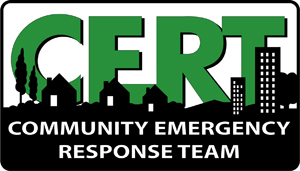Community Emergency Response Team (CERT)

Being trained on how to respond during an emergency situation or a disaster in your own community, at work, or on vacation is one of the most important things you can do to assist others when professional responders are not immediately available to help. CERT members also provide critical support to professional responders during an emergency situation or a disaster.
Mission
To promote hazard identification and mitigation in an effort to minimize the effects of a disaster in a community and facilitate recovery.
Use these links for more information:
Training is Free
Graduates of the program may be given the opportunity to join the CERT Program.
Upcoming CERT Training
Training Classes Start September 2, 2025 at the Alexander Hughes Center, 1700 Danbury Road
CERT Training Classes 2025(PDF, 275KB)
To enroll, contact kroa@claremontca.us or call CPD at (909) 399-5411.
Apply to Attend CERT Training
Submit a completed application with an original signature by mail, as instructed on the form:
History
The CERT program was first developed by the Los Angeles Fire Department in 1985, and the first CERT Team completed its training in early 1986. The Federal Emergency Management Agency (FEMA) now uses the program as a national model for other communities, and former President Bush endorses this training as part of the Citizen Corps Program. In June 2003, the Los Angeles County Fire Department implemented its department-wide CERT training Program.
Neighbors Helping Neighbors
Following a major disaster, police, fire, and fire rescue resources may not be able to immediately respond to those in need. In such crisis, it will be families assisting families, neighbors assisting neighbors and co-workers assisting co-workers until emergency response personnel can arrive. Being trained on how to be prepared to respond in an emergency situation in your own community, at work, or on vacation is one of the most important things you can to do assist during an emergency.
Who are CERT Students?
- School Administrators
- Public Agency Workers
- Church Members
- Homeowners Association
- City Employees
- Business and Industry
- Community Groups
- Concerned Citizens
Good Reasons to Take CERT Training
- Within the first few minutes of a disaster, all available resources will have been committed, leaving you and your neighbors or coworkers to help yourselves.
- CERT can minimize the effects of a disaster and facilitate recovery.
- You don't have to become a CERT member to participate in and complete the training.
The City's CERT Program
The City of Claremont has its own Community Emergency Response Team (CERT) with approximately 125 members. These trained volunteers play a significant role in our community's emergency response to disasters. In addition to being ready to assist the City during times of crisis, team members also provide training to our community through the Basic CERT course and Neighborhood Emergency Preparedness meetings and training.
What Will I Learn?
Upon completion of CERT training, you will be able to:
- Describe the types of hazards that are most likely to affect your home and community
- Take steps to prepare yourself for a disaster
- Identify and reduce potential fire hazards in your home or workplace
- Conduct triage under simulated disaster conditions
- Perform head-to-toe patient assessment
- Employ basic treatments for various wounds, and apply splints to suspected fractures and sprains
- Describe ways to protect rescuers during light search and rescue operation
CERT Course Outline
UNIT 1: Disaster Preparedness
- Introduction to disasters
- Impact of disasters on infrastructures
- Role of CERTs in disaster response
UNIT 2: Disaster Fire Suppression
- Fire chemistry and basic fire suppression
- Identifying and reducing potential fire hazards
- Firefighting resources and techniques
- Introduction to Hazardous Materials Incidents
UNIT 3: Disaster Medical Operations I
- Treatment strategies for life-threatening conditions
- Principles of triage
UNIT 4: Disaster Medical Operations II
- Head-to-toe patient assessments
- Establishing treatment areas
- Treatments for burns, lacerations, fractures, sprains, and other injuries
UNIT 5: Light Search and Rescue
- Search and rescue priories and resources
- Size-up techniques and rescuer safety
- Lifting, cribbing, and victim removal
UNIT 6: Disaster Psychology and Organization
- Post-disaster emotional environment
- CERT organization: Incident Command System
- CERT decision-making and documentation
UNIT 7: Terrorism
- Risk and threat analysis
- Types of terrorism weapons
- Travel and terrorism
UNIT 8: Course Review and Simulation
- Course review
- Disaster simulation drill